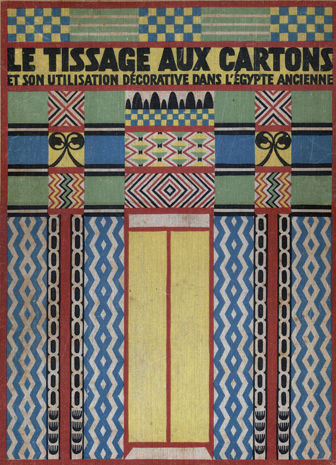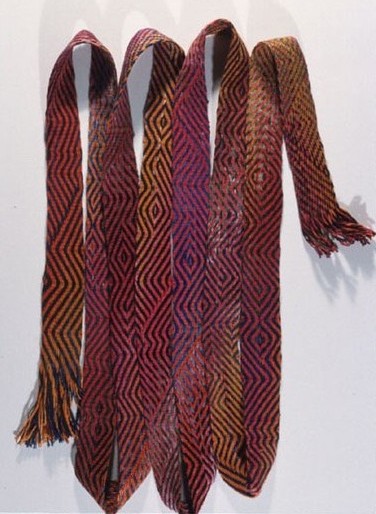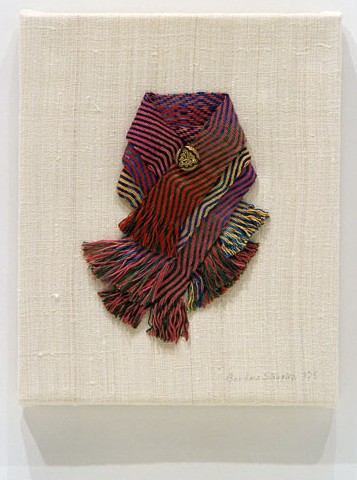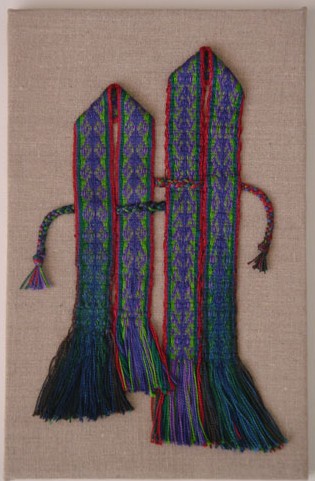SDA Members in Print: Barbara Shapiro Translates Card Weaving Classic
November 30, 2010
 Le Tissage aux Cartons dans l’Egypte Ancienne
Le Tissage aux Cartons dans l’Egypte Ancienne
(Card Weaving in Ancient Egypt)
Translation from the French by Barbara Shapiro
For the Love of Textiles & French
Little did I know that I would be embarking on a journey lasting over seven years when I undertook the translation of this book at the request of Janis Saunders, editor of TWIST (Tablet Weavers International Studies and Techniques).
I have 2 graduate degrees in French, one of which is from the University of Lausanne, Switzerland. The opportunity to bring together my two loves–textiles and the French language–was just too good to pass up, especially when I saw that the original text had been published in Switzerland. My primary concern was to provide a clear translation of a very ornately written, early 20th century French text of historic interest.
 I was not initially involved in the accuracy of the authors’ theses, since morphing their French into modern English was challenge enough! Although I practice card weaving (the 3 examples of card weaving to the right and below are mine) and am comfortable with that vocabulary, I knew little about theories of Egyptology which form the basis of this book.
I was not initially involved in the accuracy of the authors’ theses, since morphing their French into modern English was challenge enough! Although I practice card weaving (the 3 examples of card weaving to the right and below are mine) and am comfortable with that vocabulary, I knew little about theories of Egyptology which form the basis of this book.
Among certain researchers in the first half of the 20th century, weaving with cards or tablets was a newly–rediscovered “ancient” technique. Discussions of its history seemed to fascinate researchers and weavers alike. The van Gennep/Jéquier thesis, that many of the decorative motifs in ancient Egypt were derived from card weaving, was hotly contested by some and supported by others. The general current consensus is that this book’s main thesis may be questionable at best. What, then, is of enduring value? The early 20th century interest in card weaving and in ancient Egypt, the many museum collections and texts listed, the pattern categories and the instructional sections of the book most certainly are.
Did card weaving ever actually reach high and honored status in ancient Egypt? I have no pretensions that I am qualified to make such a judgment–but offer this translation for its historic interest and for the joy I took in translating a beautiful book.
I found generous encouragement from Peter Collingwood (1922-2008) particularly helpful. I have dedicated my book to him and one copy now resides in his son Jason’s library.
To place an order for Card Weaving in Ancient Egypt (Le Tissage aux Cartons dans l’Egypte Ancienne), translation 2010, please go to my web site: barbara-shapiro.com/book/le-tissage-book-order.html
The Production Saga
 The saga of production may be of interest to others who wish to undertake such a journey. Janis Saunders acquired one of the 150 original copies of the 1916 book. As far as I know, these were the only copies ever produced. The small production was due to the inclusion of many actual hand woven bands in each book. Janis used special software to transpose each page into a Word document, but the small print and age discoloring many corrupted many words. My first job was to put each page back into correct French. Translation was slow and tedious due to the complexity of the subject matter and the incredibly long and complicated early 20th century French sentence structure.
The saga of production may be of interest to others who wish to undertake such a journey. Janis Saunders acquired one of the 150 original copies of the 1916 book. As far as I know, these were the only copies ever produced. The small production was due to the inclusion of many actual hand woven bands in each book. Janis used special software to transpose each page into a Word document, but the small print and age discoloring many corrupted many words. My first job was to put each page back into correct French. Translation was slow and tedious due to the complexity of the subject matter and the incredibly long and complicated early 20th century French sentence structure.
Janis and I worked over each chapter as it went to press in TWIST over a 4 year period. I sought the help of my good friend Candace Crockett whose book Card Weaving is invaluable, Claudie Cassoret, my best friend and “French Connection” and Marie-Helene Guelton of the Textile Museum in Lyon. I read all the articles from Anne Blinks’ library that Nora Rogers sent to me and anything else I could find on the subject and the authors. I referred to Internet sources for a rudimentary understanding of Egyptology as it stood in the early 20th Century.
 When the serialized TWIST project was completed, I worked with another incredibly patient and detail oriented book editor, Anne Rock, who coaxed the text into impeccable English and print-ready copy. With seven years of work done at last, I approached Pete Masterson, author of Book Design and Production, who gave me advice on local printers. Pete’s wife used to be a weaver and so he took an interest in the book and was generous with his advice. Because of the dimensions of the book (a factor of the original charts and images) I could not use an online print service such as that offered by Amazon. I selected Patsons in Sunnyvale, CA–a good family-owned Silicon Valley printer–and they produced the book in a matter of days after I met with Account Manager Ronnie Smoot. It turns out that Ronnie is French, yet another fortunate coincidence along the way.
When the serialized TWIST project was completed, I worked with another incredibly patient and detail oriented book editor, Anne Rock, who coaxed the text into impeccable English and print-ready copy. With seven years of work done at last, I approached Pete Masterson, author of Book Design and Production, who gave me advice on local printers. Pete’s wife used to be a weaver and so he took an interest in the book and was generous with his advice. Because of the dimensions of the book (a factor of the original charts and images) I could not use an online print service such as that offered by Amazon. I selected Patsons in Sunnyvale, CA–a good family-owned Silicon Valley printer–and they produced the book in a matter of days after I met with Account Manager Ronnie Smoot. It turns out that Ronnie is French, yet another fortunate coincidence along the way.
My son works for eBay and taught me to use PayPal for sales. It’s so easy, and I can even print up postage paid shipping labels from my computer. I learned an incredible amount by undertaking this project and look forward to future French textile translation projects.
______________________________________
 Barbara Shapiro began weaving in 1975. She combines a rich knowledge of historical and ethnic textiles with broad technical experience in weaving, dyeing and basketry. Her post-graduate studies were in French. After being involved in the San Francisco Art to Wear movement in the ’70s and ’80s, Barbara shifted her focus to textile art. She teaches frequent workshops and classes at San Francisco State University. A Board Member of the Textile Society of America, she also serves on the Textile Arts Council of the Fine Arts Museums of SF and is a docent at the Museum of Craft and Folk Art. Barbara’s wall pieces and baskets have been exhibited widely.
Barbara Shapiro began weaving in 1975. She combines a rich knowledge of historical and ethnic textiles with broad technical experience in weaving, dyeing and basketry. Her post-graduate studies were in French. After being involved in the San Francisco Art to Wear movement in the ’70s and ’80s, Barbara shifted her focus to textile art. She teaches frequent workshops and classes at San Francisco State University. A Board Member of the Textile Society of America, she also serves on the Textile Arts Council of the Fine Arts Museums of SF and is a docent at the Museum of Craft and Folk Art. Barbara’s wall pieces and baskets have been exhibited widely.
For more information, visit barbara-shapiro.com

Related Blog Articles
African Textiles
Friday Fibers Roundup: Craft & Color
African Textiles
Friday Fibers Roundup: Artistic Approaches
No Thumbnail Available
African Textiles
Friday Fibers Roundup